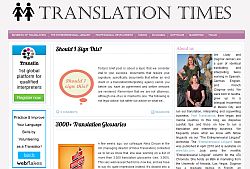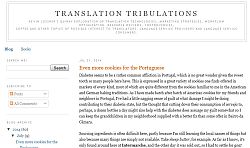
An der dänischen Universität Aarhus hat Helle V. Dam vom Department of Business Communication eine Studie mit dem Titel „The Translator Approach in Translation Studies – reflections based on a study of translators’ weblogs“ verfasst, die sich mit bloggenden Übersetzern beschäftigt.
Untersucht wurden 21 verschiedene englischsprachige Blogs, darunter diejenigen von Judy und Dagmar Jenner, Steve Vitek, Corinne McKay, Kevin Lossner, Fabio Said, Jill R. Sommer und Alejandro Moreno-Ramos („Mox“).
Dabei werden die Blog-Inhalte in Bezug auf vier Kriterien geprüft: Einkommen, Qualifikation/Kompetenz, Sichtbarkeit/Berühmtheit und Macht/Einfluss.
Gezeigt wird, dass – und wie – diese Übersetzer versuchen, sowohl ihren eigenen Status anzuheben als auch das Ansehen der Berufsgruppe insgesamt zu fördern. Die Blogosphäre ist also nicht nur ein Jahrmarkt der Eitelkeiten, sondern nützt auch der Übersetzungsbranche insgesamt.
Einige Auszüge (Zwischenüberschriften von UEPO):
Fame is generally not within reach of translators

Among the bloggers in the sample, there is clearly an awareness that translators are relatively invisible in society and that fame is generally not within reach of translators. As one blogging translator puts it: “If you crave recognition in your lifetime, this might not be the metier for you”. However, it is equally clear that blogging helps the translators gain or increase their visibility, cf. the following quote: “Most of my (and probably your) work will never be immortalized (except maybe this blog)”. That blogging is an effective means of creating visibility is also evidenced by the top-text of the blog Fidus Interpres, which reads as follows: “Fidus Interpres. Translation Blog. Over 1.5 million visitors”.
They bring visibility not only to themselves, but also to other translators and to translation as such
The translators use their weblogs to bring visibility not only to themselves, but also to other translators and to translation as such. Despite growing evidence to the contrary (e.g. Risku & Dickinson 2009), one of the most persistent ideas about translation is that it is a solitary occupation – with each individual translator working in isolation, not in contact with others. The translators in the sample, however, are clearly networkers and use their blogs to create an authentic community of blogging translators. They link to each other’s blogs, they comment on each other’s blog posts, they write guest posts on each other’s blogs, they share jokes, experiences and knowledge, and they also refer very explicitly to each other in their blog posts.
Positive cross-referencing used for self-promotion
These and other translators-cum-bloggers repeatedly refer to each other, usually in highly positive terms. This kind of positive cross-referencing is often used for self-promotion, as is the case in the above example where it allows the blogger to draw attention to her own “excellent contribution” to the book. Nevertheless, it also serves to increase the visibility of, and even promote, other (blogging) translators and the translation community as a whole.
They construct and promote heros, legends and stars

The bloggers in the sample also mention and promote translators outside the blog community. For example, in a report from an ATA conference, one blog author refers to a non-blogging translator as follows: “star translator and international speaker Chris Durban”. This leads us to a different, but related, feature of the blogs: the construction of professional ‘stars’.Translators are usually never associated with fame. As noted by Christina Schäffner (2004: 1), “there are no widely known ‘stars’ in the profession”. It is therefore interesting to note that the translators studied here construct and promote professional stars on their weblogs. Not only do they emphasize the star qualities of some translators, such as the “star translator” Chris Durban in the above quote, they also cite interviews with translators whom they consider important and write glowing, obituary-like blog posts in which fellow translators are raised to stardom. In one such post about the dying Peter Less – one of the interpreters at the Nuremberg trials after World War II and, hence, one of the first simultaneous interpreters ever – the blogger says: “the legendary interpreter Peter Less […] a true hero of translation and interpreting”.
They draw on these translators’ stardom to foreground themselves

The translation community thus has heroes, legends and stars of its own, and the blogging translators contribute to constructing and promoting them, thus suggesting that translators can be, and indeed sometimes are, famous. Not surprisingly, the bloggers not only promote other translators as stars, they also draw on these translators’ stardom to foreground themselves whenever possible.[…] In another example, which stems from an interview with one of the authors of a new book (Kelly & Zetzsche 2012), the (absent) co-author is described by the interviewing blogger as follows: “our mutual friend and translation technology guru Jost Zetzsche”.
They enhance the visibility of the profession and its members
In sum, the translators-cum-bloggers increase the visibility of other translators, themselves, and translation as such through their weblogs. They use their blogs to build authentic translator communities capable of further enhancing the visibility of the profession and its members, and they even construct and promote professional stars thus suggesting that, contrary to common beliefs, fame is within reach even for translators.
They enhance their own and the translation profession’s status

Through their weblogs, the blogging translators in the sample employ various tactics that may serve to enhance their own and the translation profession’s status. Most fundamentally, the translators make themselves visible simply by being present in the blogosphere, which gives them a voice in the crowd. But as we have seen, the translators also use their weblogs to network, build communities and bring visibility to other translators and to translation as such.
They address and refute common myths and misconceptions about translation
The translators-cum-bloggers address – and refute – common myths and misconceptions about translation and translators, they say that translators can, indeed, make good money, that translation is a highly skilled activity, that translators are competent experts in their own right and that (freelance) translators are or can become powerful, influential and even famous.
They empower both themselves and translators in general
In all these ways, the translators use their blogs to change their low-status image and as such to empower both themselves and translators in general. As one blogger puts it: “Be proud, interpreters and translators!”
Die Studie wurde 2013 im Sammelband Perspektivität als Herausforderung veröffentlicht. Der vollständige Text des 20-seitigen Aufsatzes kann unter dem folgenden Link als PDF-Datei heruntergeladen werden:
[Text: Richard Schneider. Bilder: Richard Schneider.]
